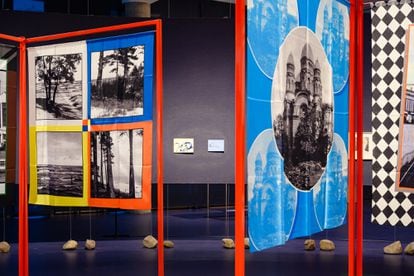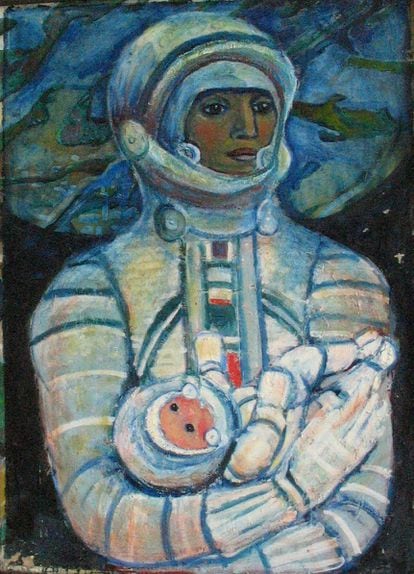The history of the Haus der Kulturen der Welt, or House of World Cultures, is also a miniature story about Berlin. In the heart of the Tiergarten park, near the new German Chancellery, the building was conceived in 1957 as a convention center — and baptized with the name, much less lyrical than the current one, Kongresshalle — and gifted to the western part of the city by the United States. Joined. Work of the architect Hugh Stubbins, assistant to Walter Gropius at Harvard, the silhouette mid-century of the building was compared, in an admirable exercise of imagination, to a “pregnant oyster,” as some still call it today. John F. Kennedy gave a speech inside in 1963, during the same visit in which he said “Ich bin ein Berliner”. In 1980, the roof of the building collapsed, as socialism was entering its final throes, and it was rebuilt seven years later, after being converted into an exhibition center that was going to pay special attention to non-Western cultures, in the wake from the multiculturalism boom soft in fin-de-siècle Europe.
Since then, the HKW (pronounced “ja-ka-vé” if you want to pass as indigenous) has attempted, with mixed success, to shake off its stigma as an emissary of Western propaganda during the Cold War. That of its new director, the curator, writer and biotechnologist Bonaventure Soh Bejeng Ndikung, a 45-year-old Cameroonian, could be the most forceful attempt. His arrival at the institution, known for a seriousness bordering on the solemn and the arid, was accompanied by a three-day party, full of music and performancesand the baptism of its gigantic auditorium with the name of the singer and activist Miriam Makeba.
Nostalgia, exile, the recovery of memory and rereadings in a feminist and 'queer' key stand out in the work of current artists from the cultural space located on the other side of the Iron Curtain.
His new exhibition project marks a change of axis in the direction of what he calls the “Global East”, the cultural space on the other side of the Iron Curtain, also beyond European borders, to which much less attention has been paid than to the western flank. The exhibition planned by the HKW for this autumn-winter focuses on modern and contemporary art created in Eurasia, a problematic geopolitical notion used, since 1914, to designate the surface of former imperial Russia, which included territories in Eastern Europe, which which allowed it to be located in the center of the map and underline its superiority and self-sufficiency over its rivals.

In the Soviet period, this fictitious union of the vast space between Eastern Europe and Vladivostok also served to strengthen Moscow's imperious centralism, which prolonged the Empire's own territorial policy, later resurrected by the emissaries of the extreme right in Russia. Putin, to whom the sample does not hesitate to throw discreet darts. The uniform vision of the former Soviet territory hid, in reality, an endless number of cultural realities that had little to do with each other and that barely survived in a context of forced industrialization, late-feudal exploitation, deliberate extractivism and deportation and extermination of dissidents.
The exhibition demonstrates that, at least during the decades of erosion of collectivism that ultimately led to the perestroika, Moscow allowed these local cultures to subsist in a folkloric version, devoid of any political burden, as a symbolic counterpart to the acceptance of its totalitarian power. This allowed, after the fall of the wall and the disintegration of the USSR, that cultural heritage to be claimed by new generations who no longer felt criticism as a taboo. The process of reappropriation is perfectly illustrated in a modest exhibition, but with great intellectual ambition, which explores the roots of issues such as nostalgia, exile, migration, rereadings in a feminist and queer or the effortful reconstruction of an adulterated memory in the work of artists from Poland, Belarus, Ukraine, the Baltic countries, Kazakhstan, Kyrgyzstan or the different corners of Siberia.

Few artists exhibited here are known in the Western world, which says a lot about the lack of curiosity that governs their legitimation systems. It is no coincidence that the most interesting belong to the generation born in the eighties, the first to grow up in relative freedom. Jaanus Samma, 41, proposes a photographic uchrony in which Riga emerges as a holiday destination for homosexuals, turning the center of the Latvian capital into a cruising area. The Tatar artist Yäniyä Mikhalina evokes in a video the suicide of Söembikä, a heroine of that Siberian town who jumped from a bell tower to avoid being forcibly married to Ivan the Terrible. With her textile collages, Małgorz
ata Mirga-Tas recalls the dissidence of the Roma women in her family in communist Poland. And the Indian artist Afrah Shafiq, 34, exhibits an interactive video game that takes up the imagery of Soviet tales, widely translated in Southeast Asia in the name of soft powerand contaminates them with figures from Armenian, Ukrainian, Lithuanian or Sami folklore.
The exhibition, which successfully alternates past and present without prior notice, finds a genealogy to the political mischief that these works give off in the work of artists who opted for a subtle and innocuous-looking dissidence. For example, the Moldovan Valentina Rusu-Ciobanu, who in the sixties signed social altarpieces that subverted, with a great sense of irony, the language of socialist realism and its obligatory exaltation of the worker. The room she shares with one of her contemporaries, the Ukrainian Galina Konopatskaya, might be the most memorable. It is presided over by a painting of the latter, Cosmic Mother (1970), which alters the Soviet myth of the cosmonaut by turning a woman with her baby in her arms into an intersiderial Madonna, invalidating the warrior imaginary of the space race and predicting a future where care would be more important than weapons. She was wrong, at least for the moment, which does not detract from the beauty and relevance of her diagnosis.
'As Though We Hid The Sun in a Sea of Stories'. HKW. Berlin. Until January 14.
Subscribe to continue reading
Read without limits
_
#art #Soviet #dissidence
